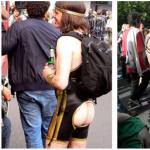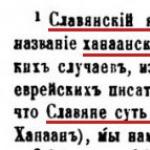Good afternoon friends!
Tell us how and where you store knitting needles, hooks, threads and needles, and other handicraft supplies? Is everything convenient and laid out on shelves so that you can quickly find the item you need?
No? Maybe it’s worth sewing an organizer then? I recently came across some interesting ideas. I was already preparing a publication on how to sew an organizer, and then Olya Arisep, my regular reader, shared that she had sewn herself an organizer for knitting needles and hooks. I asked Olya to tell you about her work for all of you.
Olya is a wonderful needlewoman, a jack of all trades, she knits incredibly beautiful socks and booties, and sews such charming fluffy toys! She has already shown us a couple of hers.
If you don’t know Olya yet, she will now tell you a little about herself.
« Good day to all!
My name is Olga Arisep. I live in the beautiful big city of Omsk. I have been doing all kinds of handicrafts since school.
My girlfriend and I were constantly making something out of rags, paper and cardboard, natural materials. They made and came up with games and skits with what they themselves created. Using patterns from the Rabotnitsa magazine, we sewed glove puppets, came up with scenes for them, and acted them out ourselves for our parents and brothers.
I started learning to knit at the age of 8, first for dolls and teddy bears, and very quickly switched to knitting jumpers for myself, and already in the 9th grade I started knitting to order.
For each season (autumn, spring) I came up with a new knitted hat for myself and tied up the “old one”. One day a neighbor told me that the neighbors even made bets on what kind of hat I would knit this time.
I learned to sew clothes at school and at home I “consolidated” my skills with my mother - I sewed things for myself. I still sew clothes for myself, because... The clothing industry standards and styles “don’t really suit me.”
She is a philologist by education and graduated from a classical university. She worked as a proofreader in various publications in our city. Most recently, she has been a proofreader for the handicraft magazine Masterklassnitsa«.
All of Olya's Works can be seen on her VKontakte page.
How to sew an organizer for knitting needles, hooks and small items
I've been needing a craft tool organizer for a long time.
When you finally get tired of looking for it every time necessary tools looking at different cabinets, shelves, boxes, I started looking on the Internet for how to sew an organizer.
I came across a lot of organizers, but they “suited” me according to the principle “if only my nose……. put it to your lips………".
Then I called my eldest son (he is a professional designer) for help. My son advised me to collect everything that would be stored in the organizer and, based on their sizes, determine the size of the pockets.
So I did.
Determining the size of the organizer
Since I had to have knitting needles in the organizer (and they are quite long, especially the old ones, from my mother’s, their length is longer than the standards of modern knitting needles, and pencil cases are not suitable for them at all), this means that the pockets for the knitting needles should be slightly higher in height above the longest knitting needles, and the front wall of the pockets should be lower so that the knitting needles are visible, but at the same time the knitting needles should not fall out of the pocket.
The organizer should also store crochet hooks and knitting needles for socks - they are shorter, which means the height of these pockets is less. I also determined it by measuring the height of my hooks and stocking needles.
The organizer should also accommodate various little things: small tools and sets of sewing needles (it’s especially difficult to find them every time in boxes and cosmetic bags) - there’s a third row of pockets for them. And for sets of needles, the pockets should be the smallest in height.
The third row of pockets consists of two halves, cut from two parts of different heights and sewn together in height.
The “outer wall” piece should be slightly larger than the large pocket piece.
How to sew an organizer with your own hands
The material used was denim. You can sew an organizer, but I don’t have one.
I cut out all the details and sewed them on the machine with a zigzag stitch.
The top edge of each piece was turned inward and stitched.
Now we collect the pockets, each separately.
We apply the top short part to the bottom large wrong side to the face, combine the bottom and chop it off.
We do not sew the side seams and the bottom! They will be sewn together when assembling the organizer.
We draw out the pockets. By empirically measuring the future contents, it was determined that it is more convenient to make the width of the pockets 4 - 6 cm, this is enough even for modern knitting needles in a package. There should be a double stitch between the pockets, for which we set aside 0.5 cm.
The length of the organizer, as well as the number of pockets, was determined by the number of knitting needles. There will always be something to put in small pockets, if only there was somewhere to put it.
The pockets of the third, smallest row, can be made wider depending on what you intend to store in them.
We sew out the pockets of each three big pockets. I have an organizer from denim, for the stitching I took bright pink threads.
The upper part of the large pocket seemed a bit empty to me and I decided to decorate it with embroidery.
I found pictures of various handicraft supplies, copied them onto fabric and embroidered them along the outline with colored threads using a needle-forward stitch, and filled in some details inside the outline using the same stitch.

When all the pockets are ready, pin them together, matching the bottom edge and sides. We pin the upper “outer” part of the organizer to them facing the pockets and sew along the perimeter on three sides.
The upper part of the large pocket and the top of the “outer” part were turned inward and stitched - between the large pocket and the outer wall, as well as between the pockets, additional large pockets were obtained.
Turn the organizer inside out. To make the corners turn out better, carefully cut the corners close to the seam, but without touching the seam, otherwise there will be holes.
The organizer is ready! You can steam it with an iron and begin the most enjoyable part - filling out the brand new organizer.«
Olya, thank you very much for such a detailed description!
The master class didn’t work out for us, we just didn’t think about it, but it seems to me that everything is simple here and now it’s quite clear how to sew an organizer.
I would also recommend using non-woven fabric when using thin fabrics.
And you can store any handicraft supplies in it: the organizer is suitable for knitting needles, hooks, and various small items.
It can be rolled into a tube, tied with a beautiful braid and stored on a shelf in the closet.
You can sew a vertical organizer by hanging it on a crossbar on the wall in a craft corner.
If you still need patterns, I present a diagram of a simple organizer, which was published in the Verena magazine. Scheme .
I came across another one in the same magazine interesting idea: make a basket - organizer (picture above).
How to sew an organizer - a basket
Such an organizer can be sewn on the basis of any basket with vertical edges; you can even use sour cream buckets for small organizers or paint cans, or you can cardboard box take it, you get a square-shaped organizer.
For decoration you will need some fabric of two types that are in harmony with each other.
Before we start sewing, we measure the perimeter and height of the basket and draw a diagram like this.
We cut out two strips with a length equal to the perimeter of the basket (+ 2 cm for the allowance), and a width twice the height of the pockets. Let's say one strip is 24 cm wide, the second is 44 cm.
The inner cover of the basket should be twice the height of the basket.
How to sew an organizer:
Fold the stripes with pockets in half lengthwise and iron them.
Place the stripes on top of each other and on the cover, matching the bottom.
We mark the locations of the pockets and sew them.
Then fold the cover in half lengthwise, face inward, and stitch side seams.
Cut a fabric bottom to the size of the bottom of the basket and sew it to the cover.
Turn the cover inside out, try it on the basket, adjust the top edge and stitch it.
Anyone who does knitting and other needlework will need an assistant such as an organizer for storing knitting needles, hooks and other knitting accessories. Such organizers can be different: folding with a clasp, in the form of a book or handbag with pockets, wall-mounted or over-the-door, in the form of a small textile basket with pockets and others.
My mother loves to knit and asked me to sew her such an organizer with loops so that it could be hung on nails in the closet. She and I drew the pattern together, taking into account her wishes. The size of this organizer is 30x35 cm with loops on the upper corners.
We will need: 2 colors of fabric, thread, scissors, pins, measuring tape. For the base, take a strip of fabric 30x70 cm and fold it in half with the wrong sides inward.

For the pockets, we cut strips, the size of which is indicated on the pattern + about 1 cm on the sides for hems and seams: 25x12 cm, 15x10 cm and 10x18 cm. Each of these pockets will be divided into two.

From a plain fabric, cut a strip 4 cm wide, bend it in half in length, fold the edges inward and sew it to the upper sides of the pockets. You can use ready-made binding.

Sew on the pockets (folding the edges on the sides) in accordance with the pattern.

Then we sew each pocket down the middle, dividing it into two (as shown by the dotted lines on the pattern).

Again, cut a strip 4 cm wide, bend it in half in length, fold the edges inward on both sides and sew it onto all 4 sides of the organizer (starting from the top corner, immediately forming loops).



I made this organizer for knitting needles and hooks for my mother.

Later we sewed another small pocket in the upper free part. The size of the pocket part is 16x10 cm. Mom was pleased.

Hi all!
Today we will sew an organizer for knitting accessories

As a gift or for yourself, it’s up to you to decide, but in any case, to clearly present the task - what size, what will be there and how it will be decorated - a sketch is needed.

Having even such a clumsy sketch in front of your eyes, it’s easier to decide what and why you’ll sew - and the chance that you’ll forget to sew on the right pocket comes down to %10 out of 100 possible :)))
A little more detail about the design: (I indicate all sizes in finished form)
height 42 cm
width when unfolded is 45 cm, folds in three, width when folded is 15 cm.
closes with ties
The central part of the organizer can be either made of contrasting fabric or embroidered.
Filling:

long, straight needles/ double needles/ circular knitting needles on fishing line/ hooks/ ruler for measuring needle diameter/ row markers/ needles for knitwear/ fork for slipped stitches/
Ready? Go:)
1. Let's start with the outer part of the organizer - and the first thing we need is ties. ATTENTION! I indicate MY OWN SIZES for the sample given in the example, taking into account seam allowances of 1 cm, except for moments where allowances are specified separately.
We cut two strips: the first 4 x 35 cm, the second 4 x 50 cm. You can make it the same length, but in the end one will still be shorter than the other :) Fold it in half with the front side inward and sew a line, departing from the edge 0.5 cm.

2. Close one end, leave the other open. We cut the allowance diagonally, close to the stitching.

3. Turn inside out and iron.

4. Let's start cutting and assembling the outer part. It consists of a main fabric and a contrasting or embroidered motif, which is also a way to attach the ties.
We take a piece of fabric (minus the size of the central motif - in the example: -12 cm) = 39 x 42 cm (height - grain thread) and a strip (contrast fabric or embroidery) 12 x 42 cm. Glue it with thin non-woven fabric or dublerin. We glue or duplicate the embroidery so that it does not show through.
5. Place the 39 x 42 piece face up and set aside right side 4.5 cm at top and bottom. We carry out vertical line and cut along it. We get two parts: 34.5 x 42 and 4.5 x 42.
6. Assemble: leave the large piece face up, mark the middle on the right side, take a tie (50 cm) and baste it with an open cut to the middle. We place the bar (embroidery) face to face, aligning the right edge. We sew, keeping an allowance of 1 cm. We iron the seam in one direction, with a slope towards the bar. We lay the workpiece face up - a large fabric + embroidery + a tie is secured between them.
7. On the right side of the strip (embroidery), mark the middle, baste a short tie to it, with the open end in the seam. Take the remaining piece (4.5 x 42) and place it right side to right side. We sew, keeping an allowance of 1 cm. We also iron the allowance onto the bar.

We get the following detail:

You can sew on lace and decorative braid. The outer part of the organizer is ready. Iron the part and set it aside.
8. Let's start cutting and assembling the inner part. It consists of a common backing and pockets.
The backing should be the same size as the top part of the organizer - on this moment 47 x42 cm. We glue it with VOLUME non-woven fabric or baste fleece (then we work as with a single-layer part)

9. Decide on the size and decoration of the pockets, further description for the presented example:
For long knitting needles - a piece with a height of 26 x 32 cm. The top decoration is 5 x 32 cm. We fold the pieces face to face, sew them together, and iron the seam. We glue it with thin interlining. We turn the finishing part allowance of 1 cm to the wrong side and iron it.

10. Turn the part face up and stitch to the edge, securing the allowance. Sew on the lace. Let's iron.

11. Bottom tier - compartments for hooks and stocking needles - part 14 x 32 cm high, glue (decorate), turn the seam allowance to the wrong side, iron. We stitch to the edge.


12. Take the backing face up and place tiers on it on the right side under the knitting needles - first a large section, a smaller one on top, aligning all the parts along the bottom edge.

13. We cut out pockets for circular knitting needles - in my case, 4 pieces 15 x 17 cm high, glue them, turn the seam allowance of 0.5 cm to the wrong side - iron, fold the seam allowance of 1 cm again, iron and stitch along the front side, stepping back from the fold 0.7 cm (per foot width). In this way we process all 4 pieces. On the lower (future) pocket we sew a piece of felt to store needles for knitwear.

14. On the left side of the backing we lay out the pockets we made, starting from the top. The top edge of pocket 1 should match the top edge of the tall knitting piece. We lay out the remaining pockets evenly, at the same distance:

15. Baste the small section to the large piece and align the resulting edge with the edge of the column of pockets, face to face, sew, keeping an allowance of 1 cm. Iron the seam in different directions.


The pockets are sewn on only one right edge!

NOTHING has been sewn to the backing yet!
16. Place the resulting part on the backing, aligning the sides and bottom. Now you need to decide on the stitch size - this point is especially important for those who use not adhesive materials, instead of voluminous non-woven fabric. You should definitely quilt!

the stitch should end just below the top edge of the sections and pockets

The stitching will further decorate and secure the seal.
17. We begin the main assembly: again we place the part with the pockets on the backing, aligning the sides and bottom. We chop it off. We sew the part into the seam (joint) of the sections and pockets to the backing.

18. Form the bottom of the pockets - Fold the carcasses to the right, leaving only the detail of the upper pocket. We level, we chop.

We place the needle clearly in the seam and sew the bottom of the pocket, departing from the bottom 0.5/0.7 cm

At this stage, the pocket can be stitched again, but vertically, dividing the pocket into two parts - narrower for a ruler, wider for markers.

We repeat the assembly algorithm one by one for the remaining pockets - align, chip, stitch:

19. Mark the compartments for straight knitting needles and sew -

can be made as in the example: narrower/wider, can be made the same size. Align the side sections and baste them to the backing.
The internal part is ready.
20. We place the outer part face up, carefully pile the ties in the middle so as not to sew it where we don’t want it :))) On it, face down, we place the inner part - the backing with pockets. DO NOT MIX THE TOP AND BOTTOM OF THESE PARTS!

We cut ONLY the side seams. Sew, keeping an allowance of 1 cm.

21. Turn it inside out. Straighten and align the seams. We sew with oblique stitches. ironing.

22. We will process the top and bottom with binding. Since the cuts are straight, there is no need to cut the binding on the bias. Using this organizer as an example, I also had the opportunity to talk about what, in my opinion, is the most accurate way of sewing on binding, although not the fastest :)
We will need two strips 4 cm wide and a length equal to the length of the organizer + 4 cm for allowances. I don’t announce the final length for the simple reason that during the sewing process it could have changed due to minor shifts and it would be better to measure it further :)
Iron the seam allowances on the wrong side, 2 cm on each side, and fold the tapes in half lengthwise, wrong side inward. Iron.
Organizer for knitting needles and hooks - conveniently store and transport all knitting tools, concentrated in one place, which do not ring, do not rattle or scatter.
I’ve been wanting to sew a patchwork Carpenters Wheel for a long time, so I decided to fold it on the front side of the organizer. There are a lot of MKs on the Internet. The field consists of 8x8 squares of 2 inches = 16 inches or about 41 cm. Just the length of the longest knitting needle.These are my thoughts:
It turns out easier and more neatly if you sew not from triangles, but from squares. A way to quickly sew squares made from triangles is as follows: fold two squares face to face, draw a diagonal,
we lay two lines at a distance of 1/4 inch from the diagonal line,
cut along the diagonal line,
it turns out two identical squares consisting of triangles. We take the squares 2.5x2.5 inches, the result is a two-color square 2x2 inches. This quick method is good if you need a lot of identical half squares. But in my Carpenter’s Star, all the details are of different colors for the rainbow circle, so the second square from the pair obtained in this way will go to the second star, for example, to a pillowcase...
So, we cut two-color squares 2.5x2.5 inches, single-color squares 2x2 inches. We select color scheme... the most difficult creative torment! The most interesting!
Sew the finished squares into horizontal lines
Then we sew the horizontal lines together into a square.
Add a frame: 3 cm at the top and bottom, 4 cm at the sides.
In finished form we should get a rectangular part 45x49 cm
A dishcloth will serve as a filler to add volume when stitching a star around the perimeter.
oops, there wasn’t enough for a corner, but no one will know about it...
Details of an organizer made from old jeans:
Main part 45x49 cm
Top flap 10x49 cm
Large pocket 31x36 cm
Small pocket 10x36 cm
4 side pockets 14 cm height x 16 cm width:
I made my own bias tape from cucumber satin. Finish all parts with bias tape - the rounded edge of the top flap, the top edges of all six pockets.
Place the large pocket and small pocket together with their bottom sides facing the lower right corner of the large piece. Sew vertical stitches to form pockets for knitting needles and hooks, 2cm apart and 4cm apart.
Attach 4 small pockets to the edge of the large pockets, face down, distributing them evenly in height.
Sew them edge to edge with a vertical stitch.
If you turn them to the front side you get a picture like this:
but we will turn them off one by one, starting from the top: having turned them off, we attach the bottom side of the pocket:
Then, one by one, unscrew the second pocket, stitch the bottom of the pocket,
Unscrew the third pocket, stitch the bottom to the main part and
We turn away the fourth pocket and attach the bottom side to the edge.
We will attach a large flap to the upper edge of the large part.
Let's fold two finished parts, a denim one with pockets and a patchwork one with Carpenter's Star, back to back, and finish the perimeter with bias tape.
An organizer for knitting needles and hooks is an incredibly convenient and practical thing that allows a needlewoman to always keep her working tools in order. Making it yourself is quite simple. This will require 1 hour of free time, two types of fabric as the base of the organizer, lace for decorating pockets and as ties, sewing machine, cutting scissors, ruler, tailor's chalk or dry fine soap for drawing lines on fabric, iron, needles or pins. To make an organizer, minimal sewing skills will be enough, and therefore even an inexperienced needlewoman or one who is remotely related to sewing can handle it.
It is best to use cotton fabric to make an organizer. It is easy to care for and easy to wash. Its only drawback is the high degree of shrinkage. Therefore, before cutting, all fabrics must be thoroughly ironed through a damp cloth so that they immediately shrink. Otherwise, during further sewing, the product may become deformed and appearance will be irrevocably damaged.
The finished size of the organizer is 32*50 cm. Two base parts should be cut out from the prepared fabrics. The front part is 37*57 cm in size, the inner part is 34*57 cm.

On the inside of the organizer there are 3 rows of pockets: the bottom one is for small items, the middle one is for knitting needles, the top one is for hooks. You should cut out the pocket parts according to the following dimensions: bottom and top – 43*15 cm, middle – 34*31 cm. The upper sections of the pocket parts need to be ironed towards the wrong side by 4 cm, and then this allowance should be folded inward and ironed again. After this, you need to fix this bend with a machine stitch, placing it 1 mm from it. This is how the top edge of the pocket is processed.

If desired, finished pocket parts can be decorated by sewing narrow lace or braid onto their front side. After this, the middle and upper pockets should be placed on the inside of the organizer, pinned along the edges with pins. Then they need to be sewn to the base part along the perimeter, and machine stitches must be laid, dividing the pockets into separate sections for knitting needles and hooks. The distance between the dividing lines should be at least 3 cm. Then even thick knitting needles and hooks can easily fit into such pockets. The middle pocket should be aligned along the bottom edge with the base piece, and the top one should be placed 9 cm from the top of the middle pocket. The bottom pocket for small items is sewn on last. It is divided into three parts by machine stitches that match the stitches of the pockets for the knitting needles.

Sew two ties on the left side of the inside of the organizer. They should be located as follows: the lower one - at a distance of 16 cm from the lower cut, and the upper one - at a distance of 21 cm from the upper cut.

Once the inside of the organizer is completely prepared, you can assemble it into a single piece. For this purpose, the front side of the organizer must be placed on the inside (face to face), pinned and sewn along the side sections with a 1 cm seam. Then the organizer should be turned onto the face, the corners straightened, and the sides ironed. The resulting kinks will help to process the upper and lower sections of the product.

The organizer must be turned inside out, guided by the bends of the sides, and the top and bottom seams should be processed, stitching 1 cm from the cuts. You need to leave a hole in the bottom seam through which the product will turn right side out. The inside out organizer should be ironed again. The opening for turning inside out must be sewn up with hidden stitches. Along the entire perimeter of the organizer you need to lay a finishing stitch at a distance of 5-7 mm from the edges. The top edge of the organizer needs to be ironed 5 cm towards the inside. The resulting valve will help the hooks not to fall out during use of the product.

The finished organizer is folded into thirds along its length and secured with ties.





